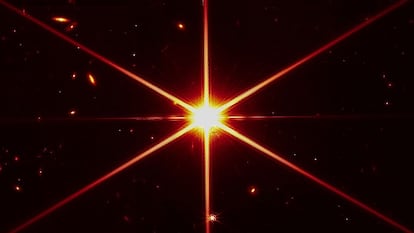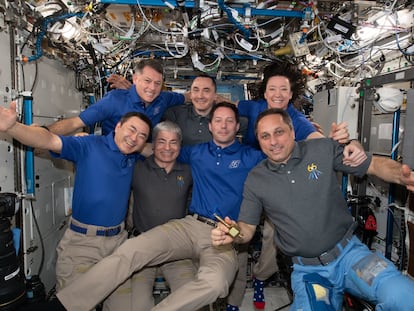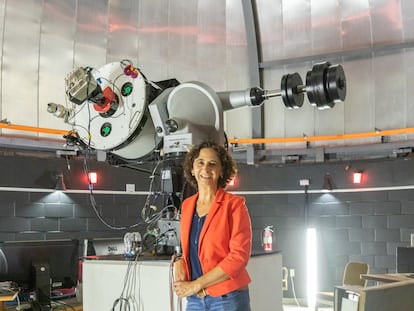How the James Webb managed to send a picture of a bright new star
The highest-resolution infrared image ever taken in space proves that the observatory is working as well as the most optimistic models had predicted
We do not know much about the star at the center of this image other than how far away it is from us, how brightly it shines and how fast it is moving (as measured by the space telescope Gaia). It is located in the Draco constellation, a mere 2,000 light years away in our galaxy, and until recently very few humans had seen it. The star is now famous because it was chosen by the team in charge of the James Webb Space Telescope (JWST) to be part of a test while the telescope completes a series of stages before it can fully capture images in space using infrared light.
This picture was taken during the mirror alignment phase, and it is the highest-resolution infrared image ever captured in space, proving that the JWST is working as well as the most optimistic models had predicted. The shot even shows details of the galaxies around the star.
We could observe this same star tomorrow before dawn from any observatory in the Northern hemisphere; say, from Roque de los Muchachos in La Palma, in Spain’s Canary Islands, where we could use the GRANTECAN segmented telescope. In fact, several of the Earth’s largest telescopes are already using segmented mirrors to watch the skies, but the JWST is the first one to do so in space.
The JWST has a primary 6.5 meter (25 ft) telescope to pick up light that is made up of 18 hexagonal segments. By comparison, the 10.4 meter (34 ft) GRANTECAN has 36 segments. For these segmented telescopes to work as a single light-collecting structure, each one of their parts needs to be moved and adjusted with great precision. It is not an easy thing to do even on land telescopes. Last week, an attempt was made at a distance of 1.5 million kilometers from Earth, and it worked.
The journey to the past, to the discovery of billions of stars in a galaxy, begins with the discovery of a single star
It’s important to remember that in order for the telescope to enter orbit, it first had to be launched inside a rocket, where it was subjected to tremendous vibration, and then be deployed in space. Now it needs to be adjusted so that everything will work properly. First, each one of the segments has to be positioned, as well as the secondary mirror that collects light from the primary one and sends it to the detectors in order to eliminate any optical aberrations. After that, each of the segments is positioned at an angle such that the light from all of them is focused on a single spot, and they are adjusted to act like a single mirror. During the entire process, it is important to know the telescope’s shape at all times, and this is what the primary mirror’s “selfie” was for. Knowing the telescope’s shape from the position of each segment, and knowing how the light is reaching the detector, it is possible to then correct any existing alignment errors.
This is what’s been done with NIRCam, the Near Infrared Camera that is the telescope’s primary imager. This device has a wide field of vision and can operate at higher temperatures than other instruments. This is useful while the telescope cools down to a more efficient operating temperature.
So what comes next? For the next six weeks, scientists will align the other instruments on the telescope. This is not quite the same as changing equipment on a land telescope, where operators can physically place and remove devices, or readjust others. With the JWST, the cameras cannot be physically moved around, so the next step is to make adjustments so that when a camera is pointed at a different target, sharp images will be obtained by all the instruments on board. This requires precise information about the relative positions of the cameras’ field of vision, and that is exactly what’s being measured now. During this process, the Mid-Infrared Instrument (MIRI) will be the last to get aligned.
But let us focus on the star again. Its name, TYC 4212-1079-1, tells us that it’s listed on the Tycho catalog, meaning that it was observed with the European Space Agency’s Hipparcos satellite, and that it is one of the 2.5 million brightest stars in the sky. This star has another name, 2MASS J17554042+6551277 (equally easy to remember!), which means it was observed during an infrared mapping effort known as 2MASS (Two Micron All Sky Survey) made by a series of small 1.3m (4.3 ft) telescopes at Mount Hopkins Observatory (Arizona) and the Cerro Tololo Inter-American Observatory in Chile.
Let us not forget the long road that comes before any milestone event. The journey to the past, to the discovery of billions of stars in a galaxy, begins with the discovery of a single star.
Tu suscripción se está usando en otro dispositivo
¿Quieres añadir otro usuario a tu suscripción?
Si continúas leyendo en este dispositivo, no se podrá leer en el otro.
FlechaTu suscripción se está usando en otro dispositivo y solo puedes acceder a EL PAÍS desde un dispositivo a la vez.
Si quieres compartir tu cuenta, cambia tu suscripción a la modalidad Premium, así podrás añadir otro usuario. Cada uno accederá con su propia cuenta de email, lo que os permitirá personalizar vuestra experiencia en EL PAÍS.
¿Tienes una suscripción de empresa? Accede aquí para contratar más cuentas.
En el caso de no saber quién está usando tu cuenta, te recomendamos cambiar tu contraseña aquí.
Si decides continuar compartiendo tu cuenta, este mensaje se mostrará en tu dispositivo y en el de la otra persona que está usando tu cuenta de forma indefinida, afectando a tu experiencia de lectura. Puedes consultar aquí los términos y condiciones de la suscripción digital.
More information
Últimas noticias
NASA discovers Titan doesn’t have an ocean, but a ‘slushy ice layer’ that increases possibility of life
Innocence lost in the forest of the child soldiers: ‘Each leader of the armed group had his girls’
‘Fallout’ or how the world’s largest company turned an anti-capitalist apocalyptic Western into a phenomenon
From inflation to defending migrants: Eileen Higgins and Zohran Mamdani inaugurate the new Democratic resistance against Trump
Most viewed
- ‘El Limones’ and the growing union disguise of Mexican organized crime
- Christian Louboutin: ‘Young people don’t want to be like their parents. And if their parents wear sneakers, they’re going to look for something else’
- The low-cost creative revolution: How technology is making art accessible to everyone
- A mountaineer, accused of manslaughter for the death of his partner during a climb: He silenced his phone and refused a helicopter rescue
- Liset Menéndez de la Prida, neuroscientist: ‘It’s not normal to constantly seek pleasure; it’s important to be bored, to be calm’












































